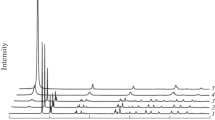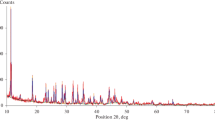Abstract
The conversion of lepidocrocite (-γFeOOH) to its more stable polymorph, goethite (αFeOOH) was followed by observing changes in crystal morphology, oxalate solubility, surface area and X-ray diffraction. In conjunction, kinetics were measured as functions of surface area, temperature, alkalinity and seeding with goethite crystals.
The results suggest that the transformation is not topochemical, but proceeds through the solution phase. The main steps governing the rate of transformation are, (1) the dissolution of lepidocrocite, and (2) the formation of goethite nuclei and subsequent growth. Either of these processes can be rate-determining under appropriate conditions.
Résumé
La conversion de la lépidocrocite (γ FeOOH) en son polymorphe plus stable, la goethite (α FeOOH) a été suivie en observant les changements de la morphologie cristalline, de la solubilité à l’oxalate, de la surface spécifique et de la diffraction X. Parallèlement, on a effectué des mesures cinétiques en fonction de la surface spécifique, de la température, de l’alcalinité et de l’ensemencement avec des cristaux de goethite.
Les résultats suggèrent que la transformation n’est pas topochimique, mais qu’elle se fait par l’intermédiaire d’une phase solution. Les étapes principales qui gouvernent la vitesse de la transformation sont, (1) la dissolution de la lépidocrocite, et (2) la formation des nucléi de goethite et leur croissance ultérieure. Chacun de ces processus peut être un facteur limitant de la vitesse dans des conditions appropriées.
Kurzreferat
Die Umwandlung von synthetischem Lepidokrokit (γ FeOOH) in seine stabilere polymorphe Form Goethit (a FeOOH) wurde verfolgt durch Beobachtung von Änderungen in der Kristallmorphologie, der Oxalatlöslichkeit, der spezifischen und der Röntgenbeugung. In diesem Zusammenhang wurde die Kinetik als Funktion Oberfläche des Ausgangs-Lepidokrokits, der Temperatur, der Alkalinität und des Impfens mit Goethitkristallen gemessen.
Die Ergebnisse deuten darauf hin, dass die Umwandlung nicht topochemisch ist, sondern über die Lösungsphase erfolgt. Die Hauptstufen, die die Umwandlungsgeschwindigkeit bestimmen, sind, (1) die Auflösung von Lepidokrokit, und (2) die Bildung von Goethitkeimen und deren Wachstum. Je nach den Bedingungen kann der eine oder der andere dieser Prozesse geschwindigkeitsbestimmend sein.
Резюме
Превращение лепидокрокита (γ РеООН) в его более стабильное полиморфное соединение—гетит (α РеООН) исследовалось наблюдением изменений кристаллической морфологии, растворимости оксалатов, поверхности и дифракции рентгеновских лучей. В связи с этим измерялась кинетика, как функции площади поверхности, температуры, мелочности и затравливания кристаллами гетита.
Результаты указывают на то, что это превращение не топохимическое, а происходит через фазу растворения. Основные стадии, управляющие скоростью превращения, следующие: (1) растворение лепидокрокита и (2) образование ядер гетита с последующим ростом. При соответствующих условиях любой из этих процессов может определять скорость превращения.
Similar content being viewed by others
References
Asami, T. and Kumada, K. (1960). Comparison of several methods for determining free iron in soils: Soil and Plant Food 5, 179–183.
Baudisch, O. and Albrecht, W. H. (1932). Gamma-ferric oxide hydrate: J. Am. Chem. Soc. 54, 943–947.
Frost, A. A. and Pearson, R. G. (1962). Kinetics and Mechanism, 2nd Edn., Wiley, New Yorks.
Hahn, F. L. and Hertricht, M. (1923). Leicht nitrierbares Eisenhydroxid durch Fallung mit Thiosulfat und Jodat: Ber. Dtsch. Chem. Ges. 26, 1729–1732.
Hiller, J. E., (1966). Phasenumwandlungen im Rost: Werkst, u. Korr. 18, 943–951.
Keller, P., (1967). Quantitative röntgenographische Phasenanalyse verschiedener Rosttypen: Werkst, u. Korr. 18, 865–878.
Krause, A., Moroniowna, K. and Przybylski, E. (1934). γ-FeOOH aus Ferrocarbonat und die Umwandlung des γ-FeOOH in α-FeOOH: Z. Anorg. Allg. chem. 219, 203–212.
Nitschmann, H. (1938). Reaktionslenkung durch Keime— The oxidation of iron in ferrous sulfate solution: Helv. Chim.Acta. 21, 1609–1618.
Oosterhout van, G. W. (1967). The transformation of γ-FeO(OH) to α-FeO(OH): J. Inorg. Nucl. Chem. 29, 1235–1238.
Schindler, P., Michaelis, W. and Feitnecht, W. (1963). Löslichkeitsprodukte von Metalloxiden und hydroxiden. Die Löslichkeit gealterter Eisen (IH)-hydroxid-Fälun-gen: Helv. Chim. Acta. 46, 444–449.
Schwertmann, U. (1964). Differenzierung der Eisenoxide des Bodens durch Extraction mit Ammoniumoxalat-Lösung: Z. Pflanz. Bodenk. 105, 194–201.
Schwertmann, U. (1969). Die Bildung von Eisenoxidemineralen: Fortschr. Mineral. 46, 274–285.
Author information
Authors and Affiliations
Additional information
The research was carried out at the CSIRO, Division of Soils, Adelaide, South Australia, whilst on a visiting fellowship.
Rights and permissions
About this article
Cite this article
Schwertmann, U., Taylor, R.M. The Transformation of Lepidocrocite to Goethite. Clays Clay Miner. 20, 151–158 (1972). https://doi.org/10.1346/CCMN.1972.0200306
Received:
Published:
Issue Date:
DOI: https://doi.org/10.1346/CCMN.1972.0200306




